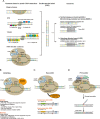Editing GWAS: experimental approaches to dissect and exploit disease-associated genetic variation
- PMID: 33691767
- PMCID: PMC7948363
- DOI: 10.1186/s13073-021-00857-3
Editing GWAS: experimental approaches to dissect and exploit disease-associated genetic variation
Abstract
Genome-wide association studies (GWAS) have uncovered thousands of genetic variants that influence risk for human diseases and traits. Yet understanding the mechanisms by which these genetic variants, mainly noncoding, have an impact on associated diseases and traits remains a significant hurdle. In this review, we discuss emerging experimental approaches that are being applied for functional studies of causal variants and translational advances from GWAS findings to disease prevention and treatment. We highlight the use of genome editing technologies in GWAS functional studies to modify genomic sequences, with proof-of-principle examples. We discuss the challenges in interrogating causal variants, points for consideration in experimental design and interpretation of GWAS locus mechanisms, and the potential for novel therapeutic opportunities. With the accumulation of knowledge of functional genetics, therapeutic genome editing based on GWAS discoveries will become increasingly feasible.
Keywords: CRISPR/Cas; GWAS; Genome editing; High throughput.
Conflict of interest statement
The authors declare no competing interests.
Figures



References
Publication types
MeSH terms
Grants and funding
LinkOut - more resources
Full Text Sources
Other Literature Sources

